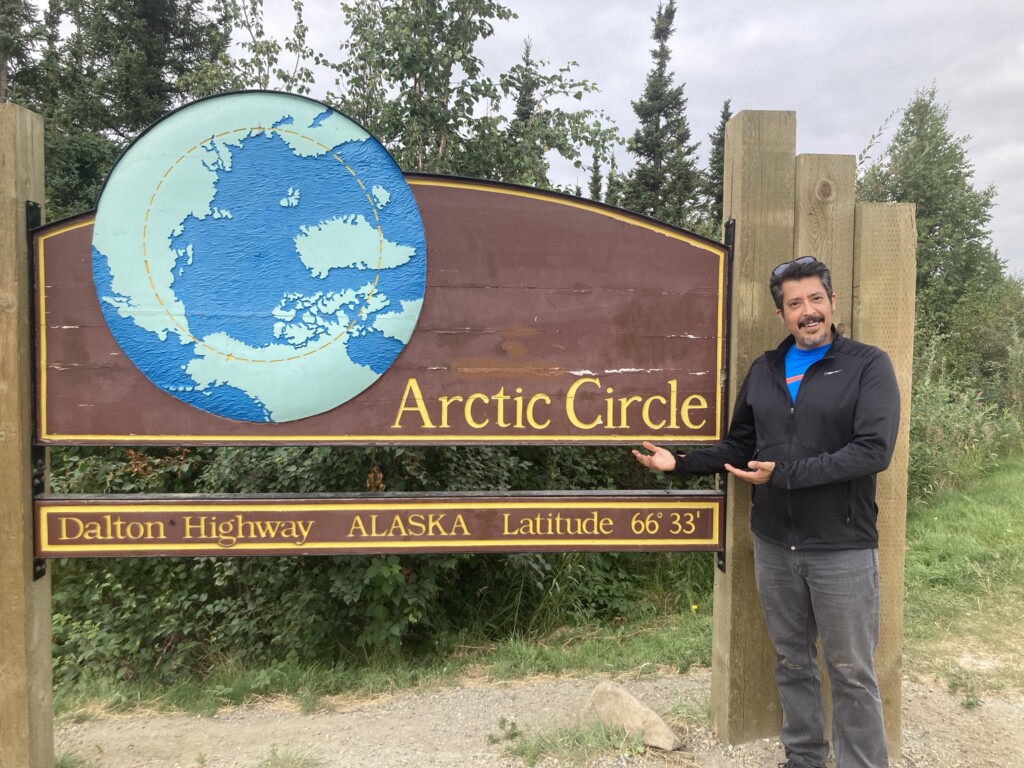 On the third day of my trip to Alaska, I was on my way to the Arctic Circle with a Jewish Alaskan, one of the so-called “Frozen Chosen.” Looking at earth as a human head, the Arctic Circle would be its Yarmulke (kippa). The land within the Arctic Circle includes eight countries: United States, Russia, Canada, Norway, Sweden, Finland, Denmark (Greenland), and Iceland — countries that may disagree yet, like the human head, opposing ideas coexist under that yarmulke. I prayed for world peace.
On the third day of my trip to Alaska, I was on my way to the Arctic Circle with a Jewish Alaskan, one of the so-called “Frozen Chosen.” Looking at earth as a human head, the Arctic Circle would be its Yarmulke (kippa). The land within the Arctic Circle includes eight countries: United States, Russia, Canada, Norway, Sweden, Finland, Denmark (Greenland), and Iceland — countries that may disagree yet, like the human head, opposing ideas coexist under that yarmulke. I prayed for world peace.
As we enter our kippah period — Yom Kippur stems from the word kippa, a shield that covers us and protects us — how should we look at the kippah, physically and metaphorically? This discussion has been going on since Biblical times, through Hellenism, and to our days. Should we look at a kippah as a custom that developed in the last few hundred years, an external sign not considered central to our identity? We are commanded in the Bible to wear the fringes of the Tzitzit outwardly. The midrash tells us that God saved us from Egypt because we kept our external signs, such as our names, clothing and language.
Modern Zionism, with its many positive and remarkable achievements, has taught us and the world, as was Herzl’s philosophy, that Jews no longer need any external signs. Fifty years after the Yom Kippur War, we are still debating the place of the Yarmulke in our lives, struggling to put it on. The six-day war was when we took the yarmulke off — thinking and attributing all our victories to our own doing.
It may sound surprising to many people, but the bottom line in Israel’s current judicial reform disagreement is about the Yarmulke. Between religious and secular — secular Kaplan Street in Tel Aviv vs. religious Kaplan Street in Jerusalem. No doubt, many overlapping issues are in play — clashes of the classes, Ashkenazim vs. Sefaradim, yes Bibi vs. no Bibi, basic laws vs. a constitution. We can keep debating until the sun sets over/in/on Alaska… But in the end, it’s about the Yarmulke. Who is our ultimate authority? (You can listen on YouTube to a lecture I gave about the Judicial reform controversy in Israel.)
When Israel’s President, Isaac Herzog, gave his speech in front of a joint session of the U.S. Congress, I was happy and proud. I had a few misgivings but ultimately, it’s always a good thing when an Israeli figure is invited to do so by both sides of the aisle. Herzog spoke about the Jewish legacy of millennia and its inseparable connection to its holy land. He also spoke about his father, who was a previous president of Israel and who spoke in front of Congress 35 years ago. And he mentioned his grandfather, who was the first Chief Rabbi of Israel, and his relationship with President Truman. But at the end, when he was acknowledging the last standing ovation as the non-political representative of the Jewish people, he turned to shake the hands of U.S. Vice President Kamala Harris and Speaker of the House Kevin McCarthy. His head was uncovered, missing something — a yarmulke — an external sign that keeps the link.
A related and amusing occurrence in our own congregation was revealed when Leah Friedman’s actor son, Paul Ben-Victor, was cast in an episode of “Curb Your Enthusiasm” as a High Holidays ticket scalper outside a big synagogue. On the day of the shooting, Leah suggested to Paul that he wear a Yarmulke in the scene. Paul replied that Larry David hadn’t asked him to wear one. But Leah, in her role as a playwright and as a Jewish mother, insisted. After the filming, Larry David approached Paul and said, “Nice touch.”
I wish everyone a Shana Tova U’mtuka, a sweet new year of 5784.
—Rabbi Gadi Capela
Get Social